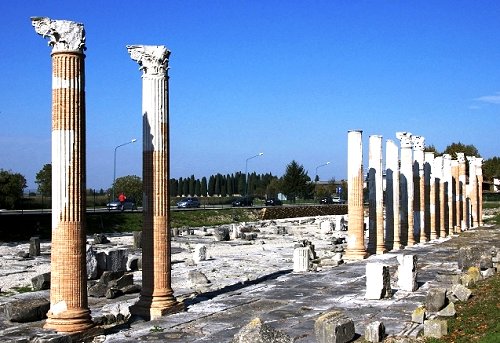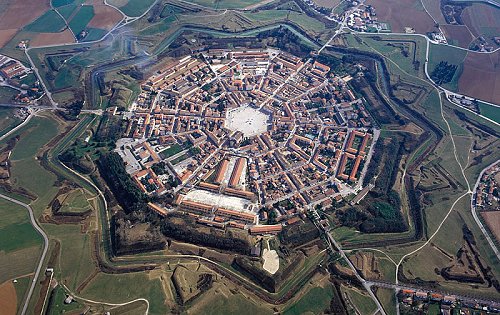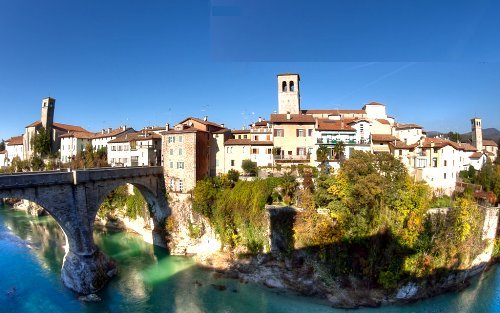|
|
Excursion 3 UNESCO heritage sites in one Day: Aquileia - Cividale del
Friuli - Palmanova Excursion from the Port of Trieste - Friuli Venezia Giulia - Italy |
|
AQUILEIA Departure from Port of Triest, Koper or Venice by deluxe Coach and drive to Aquileia. A treasure chest of history and beauty in Friuli Venezia Giulia, it lies in the Province of Udine. Traces of the magnificent Roman Empire rest here in Aquileia - a bulwark against the Barbarian Invasions, launching point for expeditions and military conquests, and large commercial hub.Patriarchal Basilica, AquileiaGiven that it was the fourth-largest city on the Peninsula for number of inhabitants, Aquileia became the Capital of the Augustan region X Regio Venetia et Histria under the dominion of Caesar Augustus. The ancient cardo (north-south oriented street), forum ruins, civic basilica, mausoleum, thermal baths and city walls make Aquileia one of the most important existing testimonials of ancient Roman grandeur. Indeed, the city was one of the largest and most prosperous political and administrative towns in the Empire, and in light of its state of conservation, is still a very important example of that civilization in the Mediterranean - so much so that it was added to the UNESCO List of World Heritage Sites in 1998 (and also because of the decisive role it played in spreading the Catholic religion). |
|
|
Located on the banks of the Naissa River (once used to transport exotic
goods), this little city was built up along the lagoon west of Trieste. It
was founded by the Romans in 181 B.C. as a defense against threats from the
Gauls. The ruins of its Roman river port are amazing, and include a quay
that is 1,312 ft long, with two docking levels and landing stages paved with
stairs (1st century A.D.). Aquileia owes its good fortune to the numerous roads linking its port to a rich and vast hinterland. This marvelous location bears significant archaeological heritage, explorable by way of the town’s three museums: the Museo Archeologico Nazionale (with many documents dating back to the Roman Era, artisan productions and finds from the ancient city), the Museo Paleocristiano (where the ruins of a large ecclesiastical building are preserved) and the Museo Civico del Patriarcato (protecting sacred wooden and metal reliquaries). The Patriarchal Basilica is of significant artistic and cultural importance. It is not quite in the town center, but rather parallel Via Sacra, overlooking Piazza del Capitolo together with its baptistery and majestic bell tower. The oldest nucleus is formed by the Aule Paleocristiane (the Paleochristian Room), built in the 4th Century A.D. by the Bishop Teodoro, with support from the Emperor Constantine. They are lasting proof of the decisive role the city played in spreading Christianity in the early Middle Ages. The floor mosaics both inside and outside the basilica are magnificent. The basilica also provides access to the Crypt of Frescoes, decorated with rare Byzantine frescoes.Damage caused by an earthquake of 988 forced the then-Patriarch Poppo to carry out radical restorations in 1031, using Romanesque forms and featuring Carolingian-Ottonian influences. The restorations culminated in the construction of the great Palazzo Patriarcale (later destroyed) and the majestic bell tower, which stands at 230 ft tall and dominates the Friulian countryside. After further restorations following the earthquake of 1348, the last significant work on the Basilica was carried out in the 16th Century, when Venetian craftsmen and carpenters were called upon to realize the impressive wooden ceiling that can still be admired today. Finally, any visit should include a tour of the Cemetery of the Soldiers who fell in WWI, located just behind the Basilica. |
|
|
|
|
| Bonaparte conquered it. After the Treatise of Campoformido the fortress entered the Austrian Empire’s area (1798-1805); and then it was conquered by the Kingdom of Italy (1806-1814). After Napoleon’s defeat Palmanova became part of the Hapsburg Empire up until 1866- with the single interruption of the insurrection of 1848.With the plebiscite of 1866 Palmanova was definitively annexed to the Kingdom of Italy. During the First World War it was the centre of hospitals, warehouses and an exercise field for drilling troops. With the rout of Caporetto the town suffered major devastation. By the end of the Second World War the fortress was the seat ( Caserma Piave) of a centre of repression against the partisans.In 1960 Palmanova became a National Monument under decree of the President of the Italian Republic. UNESCO heritage 2017 | |
|
Cividale del Friuli From Palmanova we continue via the beautif countryside of Friuli to Cividale del Friuli: a small stroll through the Devil's Bridge, the Medieval House, the Monastery of St Maria in Valle, the Cathedral and the Christian Museum, the Longobard Temple, the Orsoline Nativity Scene, the Celtic Hypogeum and the National Archaeological Museum. About religious buildings to see: the Cathedral of St Maria Assunta, the Church of St. Silvestro, the Church of St. Maria dei Battuti, the Church of St NicolÚ. The origins of Cividale Del Friuli date back to 50 BC; it was founded by Julius Caesar, who called the town 'Forum Julii'. After the destruction of Aquileia and Iulium Carnicum (Zuglio) in 452 AD, Forum Iulii became the chief town of the district of Friuli and gave its name to it. In 568 the city was the first major centre occupied by Alboin's Lombard invasion of Italy, then part of the Byzantine Empire. The city was chosen as first capital of the newly formed Lombard Kingdom, then granted by Alboin to his nephew Gisulf as the capital of a Lombard Duchy of Friuli. After the Lombards were defeated by the Franks, (774), following the last Lombard resistance under Hrodgaud |
|
|
of Friuli (776) Forum Julii changed its name to
Civitas Austriae, Charlemagne's Italian "City of the East". Under the Carolingian settlement with the Papacy, the patriarchs of Aquileia resided here from 773 to 1031, when they returned to Aquileia, and finally in 1238 removed to Udine. This last change of residence was the origin of the antagonism between Cividale and Udine, which was only terminated by their surrender to Venice in 1419 and 1420 respectively. When the Patriarchal State of Friuli was founded in 1077, Cividale was chosen as the capital. According to James Burke, a 1331 siege of Cividale was one of the first deployments of what we would now call cannons, in the early form known as a bombard. In 1420 Cividale was annexed to the Republic of Venice. After the Napoleonic Wars Cividale became part of the Lombard-Venetian Kingdom. It was ceded to Kingdom of Italy in 1866. At the end of the visit we will return to the Port crossing the beautiful vineyards of the Colli Orientali del Friuli and of the Collio area where the best wihite wines of Italy are coming from. UNESCO heritage 2011 |
|
|
Sito Regione:
Agenzia viaggi CARNIA EXPRESS -
P.IVA 00273370304 - Autorizzazione Regione FVG 351/TUR Sito Ministero del Turismo Italian State Tourism Dept. INTRAV Per informazioni e/o prenotazioni contattateci: email: info@carniaexpress.com oppure telefono: 0433-40512 |



